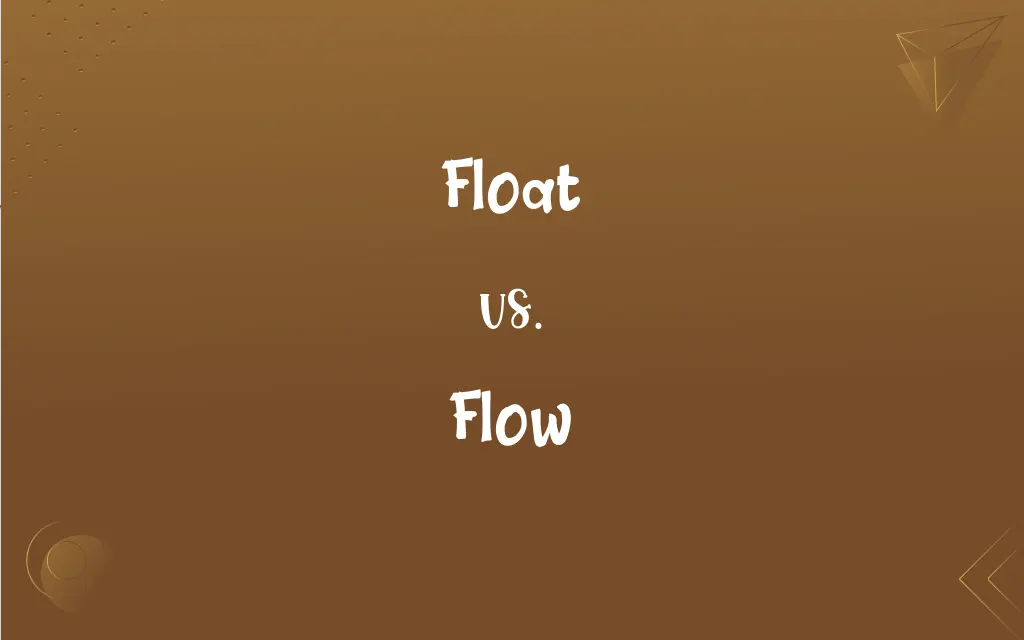Float vs. Flow: What's the Difference?
By Harlon Moss & Janet White || Updated on March 3, 2024
Float refers to an object's ability to remain on the surface of a liquid or in air, while flow describes the movement of a fluid or the continuous movement of anything in a specific direction.

Key Differences
Floating is primarily governed by buoyancy and density, where an object floats if it is less dense than the fluid it's in. In contrast, flow involves the movement of a fluid due to gravity, pressure differences, or other forces, characterized by its direction and rate.
While floating is a static condition where an object remains at rest on a fluid surface without sinking, flow is a dynamic process involving the motion of a fluid or particles within it, often observed in rivers, air currents, and in the circulation of liquids in systems.
In applications, floating is exploited in activities like boating, swimming, and in technologies such as airships, where the principle of buoyancy is crucial. Flow, on the other hand, is fundamental in hydrodynamics, aerodynamics, and various engineering systems where the movement of fluids is key.
The concepts of float and flow, while distinct, can intersect in phenomena like the floating of objects carried by a flowing fluid, where the principles of buoyancy and fluid dynamics are both at play.
Comparison Chart
Definition
The ability of an object to remain on the surface of a liquid or in air.
The movement of a fluid, or continuous movement in a specific direction.
ADVERTISEMENT
Governing Factors
Buoyancy and density of the object relative to the fluid.
Forces such as gravity, pressure differences, and fluid properties.
Nature
A static condition where an object is at rest on a fluid's surface.
A dynamic process involving the motion of a fluid or its particles.
Applications
Boating, swimming, airships, and buoyancy-based technologies.
Hydrodynamics, aerodynamics, plumbing, and fluid transport systems.
Interrelation
Objects can float in a fluid that is in flow, combining both principles.
Flow can carry floating objects, integrating the concept of buoyancy.
Float and Flow Definitions
Float
The phenomenon of an object remaining at the surface of a liquid due to its lower density.
The boat floats on the water because its density is less than that of water.
ADVERTISEMENT
Flow
The movement of liquid, gas, or electricity in a steady stream.
The flow of the river increased after the heavy rains.
Float
In fishing, a float is a buoyant device used to suspend bait at a predetermined depth.
He adjusted the float on his fishing line to keep the bait just below the surface.
Flow
In yoga, a flow is a sequence of movements smoothly transitioning from one pose to another.
The instructor led a calming flow, moving from one asana to the next seamlessly.
Float
In finance, refers to the amount of currency available for transactions.
The company's cash float ensures it has enough money for daily operations.
Flow
Flow can also describe the movement of people or goods.
The airport manages the flow of passengers through security checks efficiently.
Float
In programming, a float is a data type used to represent decimal point numbers.
The variable was declared as a float to store the fractional temperature values.
Flow
In psychology, flow refers to a state of complete immersion and focus in an activity.
She was in a state of flow while painting, losing track of time.
Float
Can also refer to a light parade entry or decorated platform.
The colorful floats in the parade were a highlight of the festival.
Flow
In business, cash flow represents the total amount of money being transferred in and out of a business.
Managing cash flow is crucial for the company's financial health.
Float
To remain suspended within or on the surface of a fluid without sinking.
Flow
To move or run smoothly with unbroken continuity, as in the manner characteristic of a fluid.
Float
To be suspended in or move through space as if supported by a liquid.
Flow
To issue in a stream; pour forth
Sap flowed from the gash in the tree.
Float
To move from place to place, especially at random.
Flow
To circulate, as the blood in the body.
Float
To move easily or lightly
"Miss Golightly ... floated round in their arms light as a scarf" (Truman Capote).
Flow
To move with a continual shifting of component particles
Wheat flowing into the bin.
Traffic flowing through the tunnel.
FAQs
How is the flow rate of a fluid measured?
The flow rate is typically measured in terms of volume per unit time, such as liters per second or gallons per minute.
What factors influence the flow of a fluid?
Fluid flow is influenced by factors like gravity, pressure differences, fluid viscosity, and the shape of the path through which it flows.
Can an object float in any type of fluid?
An object can float in any fluid if its density is lower than that of the fluid, regardless of the fluid type.
What is the principle behind floating objects moving in a flowing fluid?
Floating objects move with a flowing fluid due to the fluid's motion carrying the object, combining principles of buoyancy and fluid dynamics.
How does an object's density relate to its ability to float?
An object floats if its density is less than the fluid it's in, as buoyancy counteracts the force of gravity.
Can flow occur in solids as well as in fluids?
Flow is typically associated with fluids (liquids and gases); however, in certain conditions like in glaciers or the Earth's mantle, solids can exhibit flow-like behavior over long periods.
How does the concept of flow apply to electricity?
In electricity, flow refers to the movement of electric charge, often described as electric current, measured in amperes.
How does temperature affect the flow of fluids?
Temperature can significantly affect fluid flow; as temperature increases, most liquids become less viscous and flow more easily, while gases expand and may flow faster.
Are there objects that float in air similar to how they float in water?
Yes, objects like balloons or airships can float in air if filled with a gas less dense than air, similar to how objects float in water.
What is the significance of floating in environmental science?
In environmental science, floating is significant in studying water pollution, aquatic life habitats, and the spread of invasive species via water currents.
What role does viscosity play in the flow of liquids?
Viscosity, or the fluid's resistance to flow, significantly affects how easily a fluid flows, with higher viscosity meaning slower flow.
How do buoyancy and gravity interact to create floatation?
Buoyancy, an upward force exerted by the fluid, counteracts gravity, allowing objects with lower density than the fluid to float.
What is the role of floatation in water treatment processes?
Flotation is used in water treatment to remove contaminants by attaching them to bubbles so they can be easily skimmed off the surface.
In what ways do humans utilize the natural flow of rivers?
Humans utilize river flow for hydroelectric power generation, irrigation, navigation, and as a freshwater resource.
How is the concept of flow used in digital and network communications?
In digital and network communications, flow refers to the transfer of data packets between devices, ensuring efficient and orderly data transmission.
What is the concept of optimal flow in workplace productivity?
Optimal flow in workplace productivity refers to creating conditions where employees are fully engaged and immersed in their tasks, leading to high efficiency and job satisfaction.
How is the flow of people managed in large public spaces?
The flow of people is managed through strategic planning of space layout, signage, and sometimes personnel, to ensure smooth movement and avoid congestion.
How do cultural practices influence the design of spaces to facilitate flow?
Cultural practices can dictate the design of spaces, such as the arrangement of furniture or the direction of foot traffic, to accommodate social norms and enhance flow.
What advancements in fluid dynamics have impacted our understanding of flow?
Advancements in fluid dynamics, such as computational fluid dynamics (CFD) simulations, have greatly enhanced our understanding of flow patterns, turbulence, and efficiency in various applications.
Can floating objects affect the flow of a fluid?
Yes, floating objects can alter fluid flow by obstructing the path, creating eddies, or changing the flow direction, especially in narrow channels.
About Author
Written by
Harlon MossHarlon is a seasoned quality moderator and accomplished content writer for Difference Wiki. An alumnus of the prestigious University of California, he earned his degree in Computer Science. Leveraging his academic background, Harlon brings a meticulous and informed perspective to his work, ensuring content accuracy and excellence.
Co-written by
Janet WhiteJanet White has been an esteemed writer and blogger for Difference Wiki. Holding a Master's degree in Science and Medical Journalism from the prestigious Boston University, she has consistently demonstrated her expertise and passion for her field. When she's not immersed in her work, Janet relishes her time exercising, delving into a good book, and cherishing moments with friends and family.































































